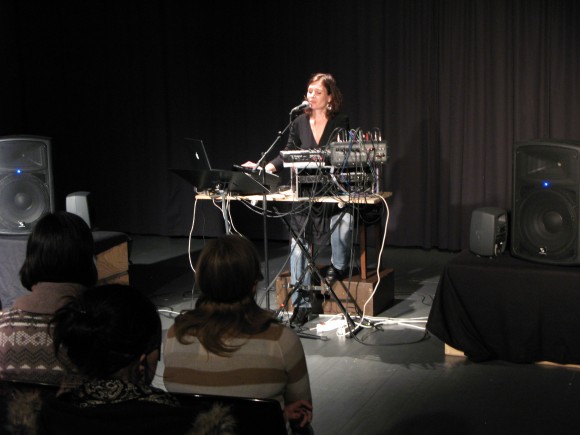After I had developed the first version of the performance, the investigation started. What we did was to stage multiple performances in different contexts, all including some form of audience feedback. The first performance was held in a small meeting room, while the final two were held in two different black boxes. All the performances were audio and video recorded.
Performing for (blindfolded) students at the DMMH, Trondheim, 2010. Photo: Andreas Schille.
During the two first performances we gathered the audience’s responses in three different ways[1]:
1) As open written feedback, no questions or guidelines.
2) As a structured, guided questionnaire[2].
3) As focus group interviews, audio and video recorded[3].
For the first two performances the audience was divided into two groups, one “seeing” and one blindfolded, and this gave us the possibility of investigating the impact of my visual appearance. This was an important part of Andreas Bergsland’s research where he wanted to compare the listeners’ experiences of live versus recorded electroacoustic music (where you listen without seeing the source of the sound). It was also interesting for me to know more about how the visual impression influenced the concert experience.
The last performance took place in a more realistic concert setting, a public symposium that provided an opportunity for audience comments and questions after the performance.
The questions asked in the interviews were related to:
– The role of the text/story as part of the whole experience
– The process of identification between performer and audience
– The experiences of ‟naturalness” and of ‟alienation”
Bergsland has been organising and using this material for analytical studies, while I have been using both the material and Bergsland’s findings to feed the artistic development of the performance.[4]
[1] Using “mixed methods”, like this, is a way of compensating for weaknesses in each of the methods in the process of collecting information, see Appendix no 4
[2] See Appendix no.3
[3] Focus group interviews: groups consisting of 9-10 audience members were interviewed after submitting their written responses by a moderator using an interview guide (see Appendix no.3&4)
[4] After this, there have been three more performances, one of which was arranged as a continuation of this collaborative research. The material from the last one had not yet been analysed when writing this, and is therefore not part of the basis for the findings that I will refer to in this text.

